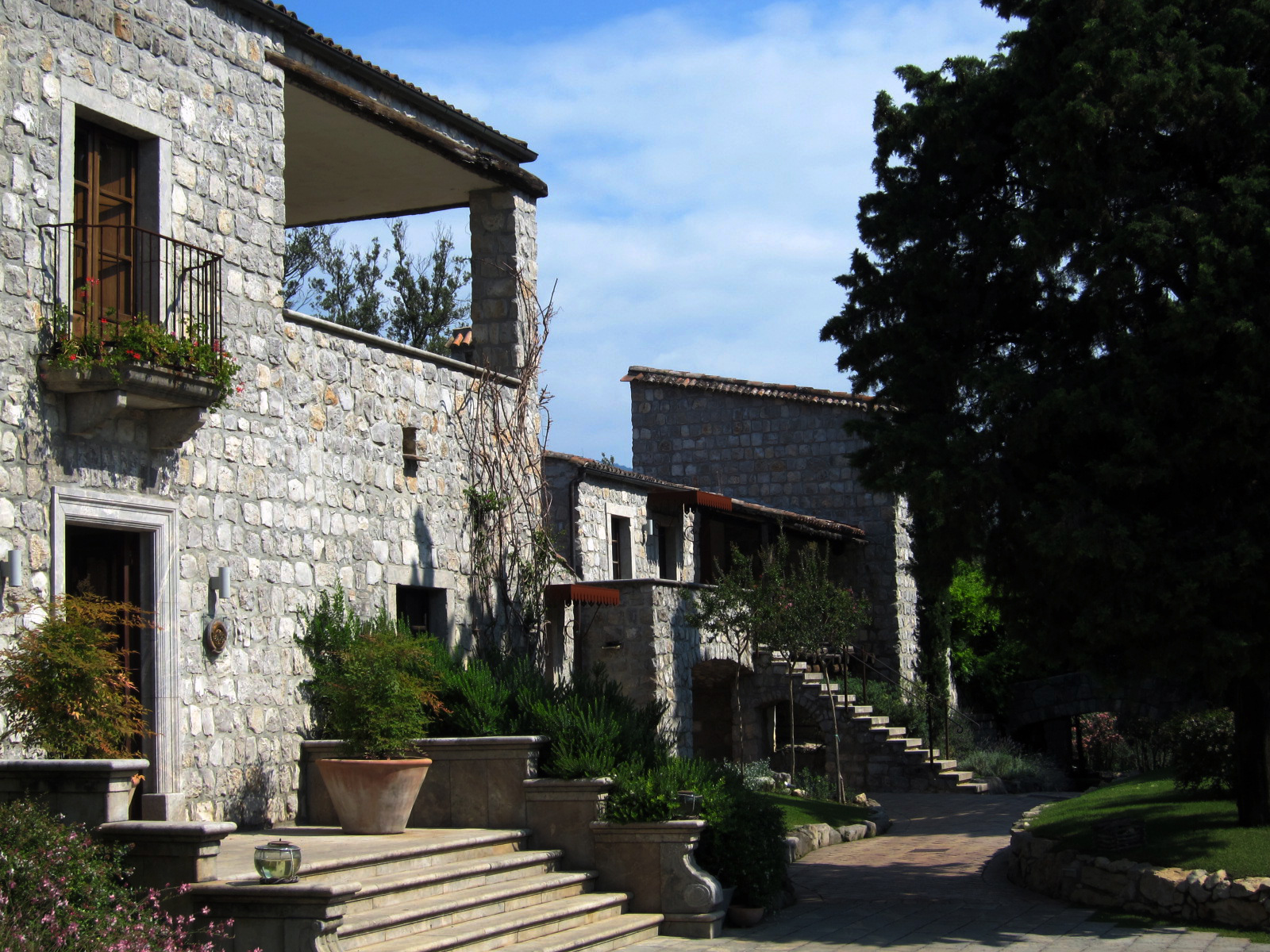 A quick stopover in Tesle Terme, Benevento in the Campania.
A quick stopover in Tesle Terme, Benevento in the Campania.
We drove to Puglia from Rome. Point to Point it would have been a 10 hr drive so we decided to take a leisurely 3hr drive and stopover at a small hotel in Tesle Terme, near Benevento, in the heart of the Campania region. We didn’t expect too much but we thought we’d get a good night’s sleep and a good meal before heading southeast into Puglia. When you don’t expect too much is usually when you get really surprised.
We booked an overnight at the Aquapetra Resort/Spa Hotel near the Casserta Palace, the largest Palace in the world in the 18th century built for the Bourbon King of Naples Charles VII.
We never made it Caserta. Once we arrived to Aquapetra we never left. The staff could not have been more attentive. Of course, there were only 6 guests in the entire hotel at the time. Gretchen had a couple of spa treatments, I had a couple of hours on the free internet and around 9pm we went down to the restaurant for dinner.
We weren’t sure if it was just a slow week or if we had stumbled on the most amazing unknown hotel in the world. The food was fantastic. Everything was either made in house or they were unique products from a nearby producers; Aglianico wines from Benevento, cheeses from Campagnia, small game hens and small (50 kilo) black pigs from Caserta, breads, grape tomatoes, hand made spaghetti, salume. Even the water was from a local source. Even the yoghurt was home made in house. It was a pretty amazing experience.
About 4 hrs into the drive down into Puglia we passed the exit for Cannae Della Battaglia. In 216BC the armies of Hannibal, around 56,000 of them, defeated a far superior Roman army of 87,000 in Cannae. It’s the most famous defeat of the Roman Empire.
Hannibal’s strategy was brilliant. After the two main armies met in battle, Hannibal signaled a retreat. The Roman troops thought they had him on the run, but instead they advanced into a trap. Hannibal’s double flank offense of light cavalry swept in from the sides and wiped out the Roman Cavalry. Then they circled around from the back and had the Roman surrounded. It became mass slaughter. By the time the battle was over, 75,000 Romans were killed. Hannibal’s losses were estimated around 8,000. According to some records, as many as 600 Roman troops were killed every minute of the battle. Hannibal was finally defeated 14 years later in 202 BC by Scipio Africanus at the Battle of Zama. The Romans eventually burnt Carthage to the ground.
When we saw Cannae Della Battaglia on the map, we thought the battlefield was right off the highway, hopefully, directly behind the service station at the exit. Nope. The service area was named for the battlefield but the real Cannae was further on down the road. The gas attendant told us to take the next exit and take the 1st left. After about 25 minutes, the next person we asked told us to go to Barletta. When we got to Via Hamilcar in Barletta we actually thought we were close. Hamilcar Barca was the father of Hannibal. Unfortunately the people we asked on Via Hamilcar had no idea what Canna della Battaglia was or who Hannibal was, or who Hamilcar Barca was for that matter. Sometimes a street is just a street.
We were determined and off we went back down the SS93 towards Canosa. Three wrong turns later we finally found a sign pointing to the monument and 90 minutes after stopping at the Highway gas station we found the ancient city of Cannae and the battlefield. It was a pretty immense archeological dig and although we wanted to hike around, we were afraid of arriving to our rental villa too late. Hours go by very fast when you get lost. We snapped a few photos, walked the lower grounds of the battlefield and said we’d come back another day. At this point in in Pugliese adventure we had no idea how bad the road directions could be. They got worse.
This part of Italy is known as the Mezzogiorno, the southern part of the country that includes Abruzzo, Puglia, Calabria, Campania, Molise, Sicilia and Sardinia. It follows the old territories of ancient Magna Grecia and more recently the division of the old Kingdom of the two Sicilies from the 13th century. Between the 12th and 19th, the area was under control of various regions of France, Spain, Germany and Italy.
Before the Italian unification in 1860, this was the largest and wealthiest part of Italy because of the farming. Now it’s the poorest part of the country because there’s is no industry. The Pugliese live a more relaxed and slower life than the hectic pace of the north.
The Mezzogiorno is home to Pompeii and Herculaneum, to the Amalfi Coast and the islands of Capri and Ischia. The best ancient Greek temples in the world are in Sicily and Paestum.
Puglia is the land of sandstone Baroque cities like Lecce, the stone hobbit houses called Trulli, the coastline of the Salento Peninsula and the heel of Italy, the 13th century Swabian castles of the Stupor Mundi, the Holy Roman Emperor Frederick II , Angevin and Argonese Castles, 13th century cave churches, great food and wines and lots more to discover.
One of the other mysteries of Puglia is that it’s almost impossible to get anywhere. The directional signs send you towards a town and then you end up in someone’s driveway or at a dead end. We have a 2008 Michelin map of Puglia. It’s easy to read and the roads look pretty good. In most cases, it looks like the road will go directly through the center of town. It doesn’t work like that here. The road goes into a town and ends, bringing you to a maze of small winding streets looking for blue directional signs that actually lead you in the wrong direction. There are S roads (larger rural roads), SP roads (smaller rural roads) and P roads (really small rural roads). Sometimes the directional signs take you way out of the way to go back to the larger S road, even though you want to go the other direction. Sometimes the signs lead you down a driveway to nowhere. We met a lot of locals yesterday. They all laughed about the directional signs and pointed us in the right direction. The people here are really, really nice but we can’t help but think some of them are maliciously changing the directional signs. One Pugliese asked if we had GPS. We told him “no”. He smiled and said it probably wouldn’t work in Puglia anyway.
We started out the day with lunch at the only 1 star Michelin restaurant in Puglia, “Al Fornello da Ricci”, run by Antonella Ricci, who is from Puglia, and her husband/chef Vinood Sookar, who is not.
Google maps told us it would take 40 minutes. Two hours later we arrived. The menu is filled with a mixture of Grandmother Ricci’s recipes as well as a lot of new inventive dishes by Antonella and Vinood. Everything is listed with a date to show when the dish was created. The earliest was 1967. The latest was 2011. We split the tasting menu and it was a good idea. The dishes kept on coming, starting with the small fried veal meatballs, to veal and rice stuffed eggplant, ricotta stuffed zucchini flowers with red potato chips, sausages, lamb chops, grilled chicken livers, a vegetable soufflé, veloute potatoes with bacon and potato croutons, millefeuilles of vegetables, lamb and veal medallions in a light creamy mint sauce and a lemon cream crisp pastry for dessert. The meal was enhanced with a very good Salice Salentino wine and a very tasty sweet local Moscato with the dessert.
There were about 25 people in the restaurant, mostly local and regulars. As one group walked by our table Gretchen smiled and said “buongiorno” to which one of the group, an elderly man came over and asked “Ti conosco?” (do I know you?). We explained we were just being friendly, but after the introduction, he then felt he did know us and very soon became our good friend, chatting us up throughout the meal. We found out later he was the health inspector and since he always gives the restaurant a glowing report he takes advantage of a good meal, at a good price I’m sure.
It was raining as we left the restaurant but our new friend assured us, after an in depth meteological review of the local weather, it would pass in 15 minutes. An hour later we arrived to Alberobello and the rain was still pretty heavy.
Alberobello is the UNESCO Heritage concentration of Trulli houses, conical stone roofed hobbit houses have become the identity of Puglia.. There are over 1500 of them in this town alone but they extend in one form or another throughout the Valle d’Itria in central Puglia. We saw some of them through the rain splattered windows of the car but we just didn’t feel like trouncing through the rain. We’re here for a week. We’ll just come back.
This city is known for its version of 17th century sandstone baroque architecture, the golden Pietra di Lecce. The Sicilian Baroque of Noto and Ragusa is very similar but the Lecce version seems to be more ornate. Some say the Sicilian Baroque is Italian influenced whereas the Lecce Baroque is more Spanish. Sandstone was easy to carve and it seems to have the property to get harder over the years after its pulled out of the ground.
In the 12th Century, the Norman King Tancred was the Count of Lecce. Supposedly, Tancred was given the mythological sword Excaliber by Richard I (Lionhearted) in order to affirm their friendship. Tancred eventually lost Lecce to relatives in Sicily and eventually it fell under the control of the Spanish. I have no idea what happened to Excaliber, but obviously it didn’t seem to help him very much.
The main square is dedicated to the 1st Bishop of the Lecce and the patron saint of the city, Saint Oronzo, who supposedly cured the city from the plague in 1656, after thousands died from it. His statue sits on top of a large column that once stood in Brindisi as a marker to the end of the ancient Appian Way, the first of the ancient Roman roads. There used to be two of the road marker columns in Brindisi. The other is still there. This one with Sant’Oronzo on top of it fell over in the late 1500’s and was purchased by Lecce and moved to Piazza Sant’Oronzo.
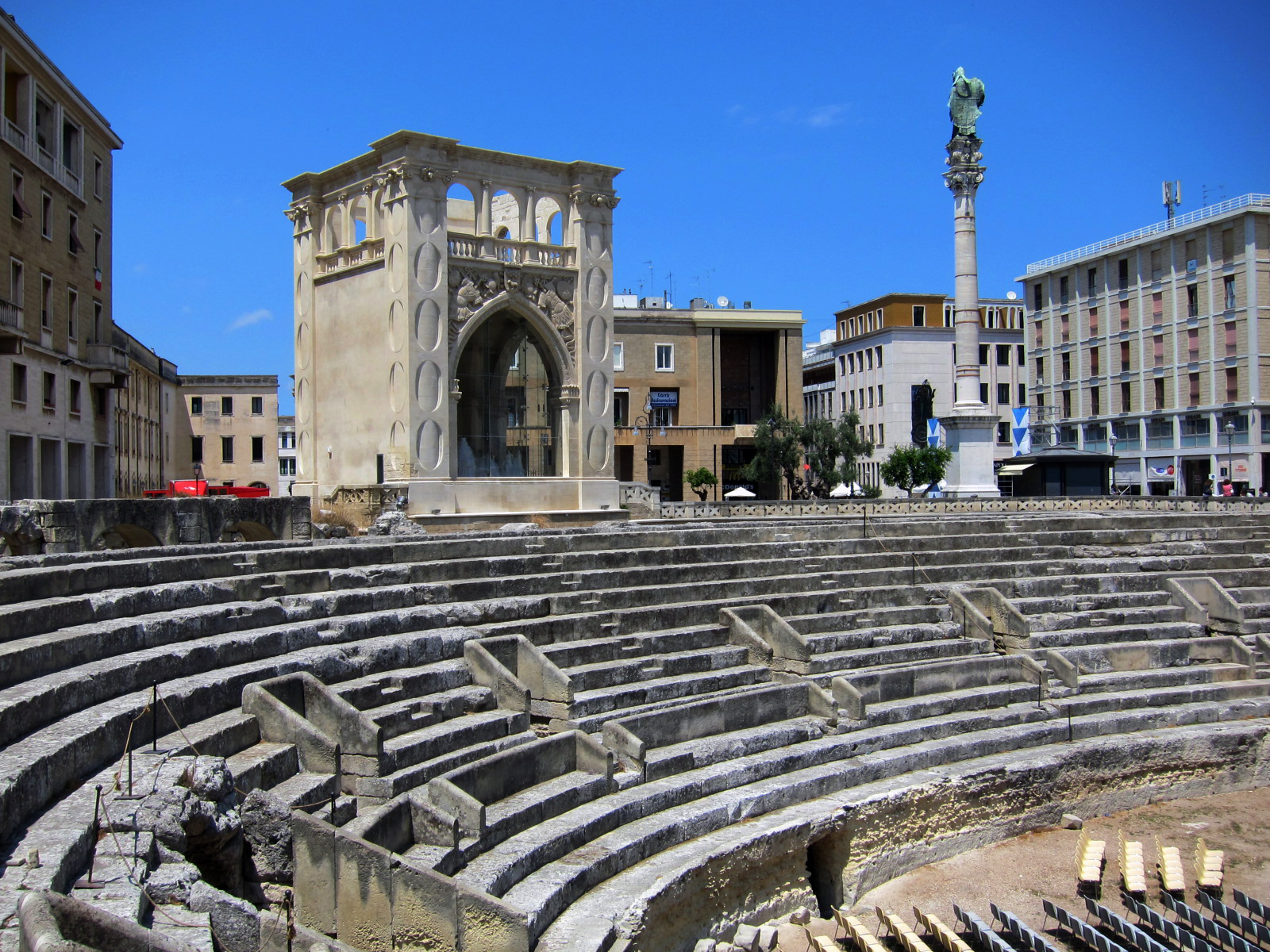
In 1901, while digging in the main square, workmen discovered the remains of a large 25,000 seat amphitheater directly under the city center. By the 1930’s a buried section was partially revealed but there were too many buildings built over it to excavate the entire stadium but the part that was excavated is the main setting of the main square and still used for outdoor concerts. There are small pockets of the ancient city revealed all around the central historical area. We walked by an ancient (possibly restored) Roman theatre and lots of little windows in the sidewalks that reveal underworld views of the ancient city.
We stopped for lunch at the Re Idomeneo Café for some Leccese cooking. Idomeneo (Idomeneus) was the grandson of Minos of Crete. He was one of Helen’s suitors and led the Cretan Army to the Trojan War. After sacrificing his own son to Poseidon, the gods got pissed at him and drove him out of Crete. He sailed to the Salento Peninsula and founded what would become Lecce. The King might have been very impressive. The restaurant named after him was not.
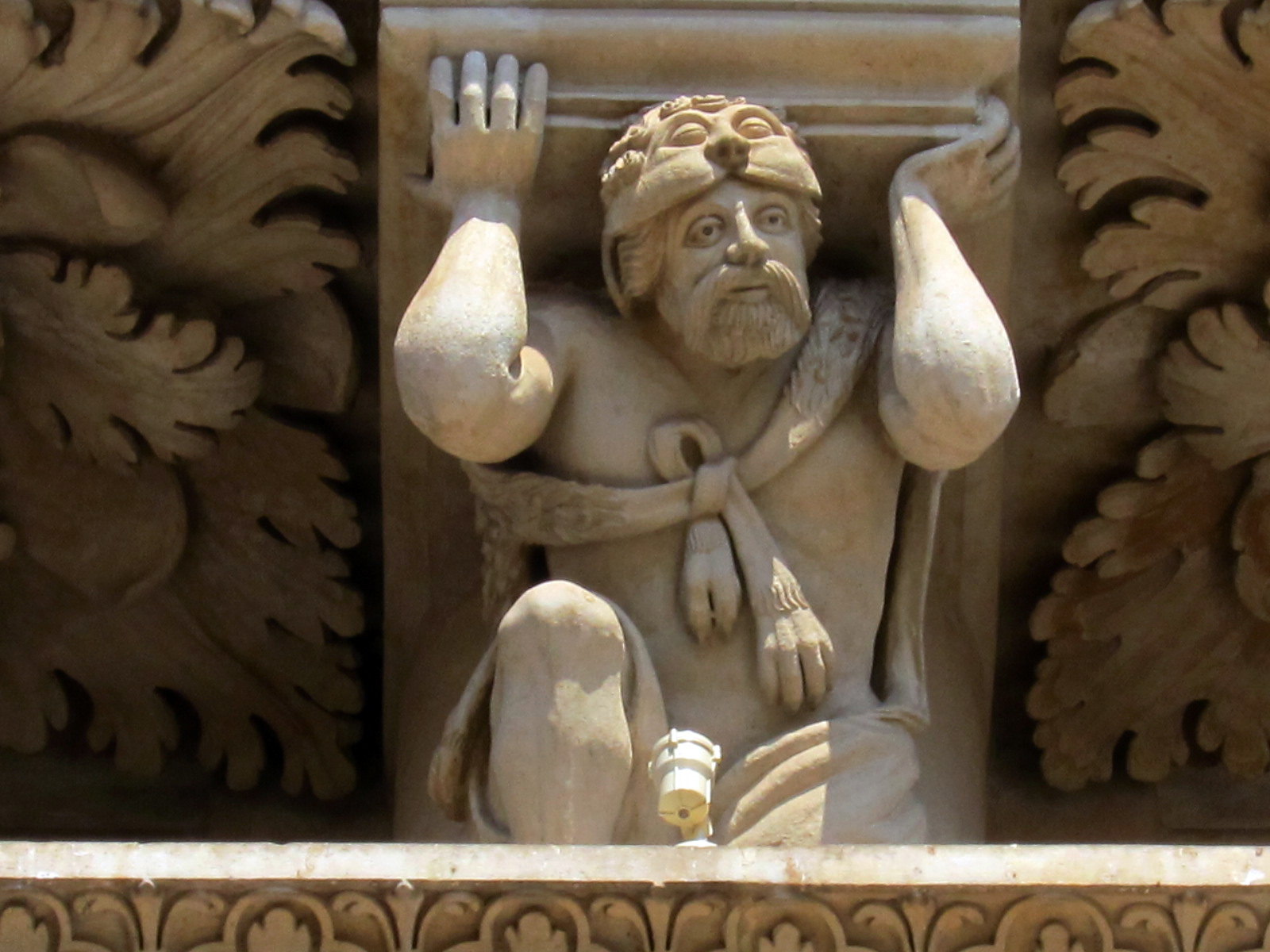 The real treat of the Lecce Baroque is the Chiesa di Santa Croce (the church of the Holy Cross) started in 1353 and finished in the 17th century. It’s chockablock with carved animals, grotesques, vegetables, vines, Hercules, the she wolf of Rome, a few dragons, a Turk, an African, Adam and Eve and lots more mythological oogly googly. The big show is on the exterior . Although the coffered wooden ceiling inside was pretty spectacular the rest of the Church can’t match the facade.
The real treat of the Lecce Baroque is the Chiesa di Santa Croce (the church of the Holy Cross) started in 1353 and finished in the 17th century. It’s chockablock with carved animals, grotesques, vegetables, vines, Hercules, the she wolf of Rome, a few dragons, a Turk, an African, Adam and Eve and lots more mythological oogly googly. The big show is on the exterior . Although the coffered wooden ceiling inside was pretty spectacular the rest of the Church can’t match the facade.
The Duomo with its 240’ tall campanile rules over the skyline but they were closing the doors just as we arrived. That’s been happening to us lately.
One final note about Lecce. The Digital clock was invented here. One of the first examples of it use to stand in the Piazza Sant’Oronzo till it broke and was carted it off to the digital dump.
We decided to take the coast road back to our rental villa on Mirante beach near Maruggio . It seemed like the straightest route and since the towns were really small on the coast we hopefully wouldn’t get lost.
We traveled south through the town of Copertino. This is the home of the 17th century levitating monk, St Joseph of Copertino. Yes, he was canonized for his ability to levitate. Supposedly thousands of people saw him do it. He is the patron saint of air travelers, astonauts, aviators and because he was kind of a simple minded fellow, the mentally handicapped. He also had the gift of smelling the bad odor of a sinfull person. When Joseph told someone they smelled bad and should go wash themselves, according to the paragons of the Church, it really meant they should go to confession to cleanse themselves.
As you enter the town there are billboards with cartoon images of a flying monk welcoming you to the city.
And yes, Cupertino CA, home of Apple is named after the flying monk.
The sun was shining and so today was our return trip to the Valle d’Itria and the land of the Trulli houses. No one really knows the origins, some think it was the Mycenaean Greeks, or the refugees from Crete that came over with King Idomeneus. Some even consider the origins to by Arab. The original trulli were constructed of limestone or tufa stone without using mortar or cement. One of the explanations from the 17th century was so they could be disassembled when the tax assesor made his annual visit in order to avoid paying property tax.
 Trulli houses are throughout the Valle d’Itria but the motherlode is in Alberobello. Over 1500 of them are this small town, dotting the vista like beehives. The current versions have fireplaces, electricity, gas, running water and mortar holding the stones together. The cones have finished stone interiors and cantilevered flat stone exteriors to keep the rain out.
Trulli houses are throughout the Valle d’Itria but the motherlode is in Alberobello. Over 1500 of them are this small town, dotting the vista like beehives. The current versions have fireplaces, electricity, gas, running water and mortar holding the stones together. The cones have finished stone interiors and cantilevered flat stone exteriors to keep the rain out.
Some have them have one cone, some two, some as many as five. Each one of the cones is topped with a pinnacle that can be round, sphere, oblong, triangular or something else. They might have some significance but they also might just be decorative.
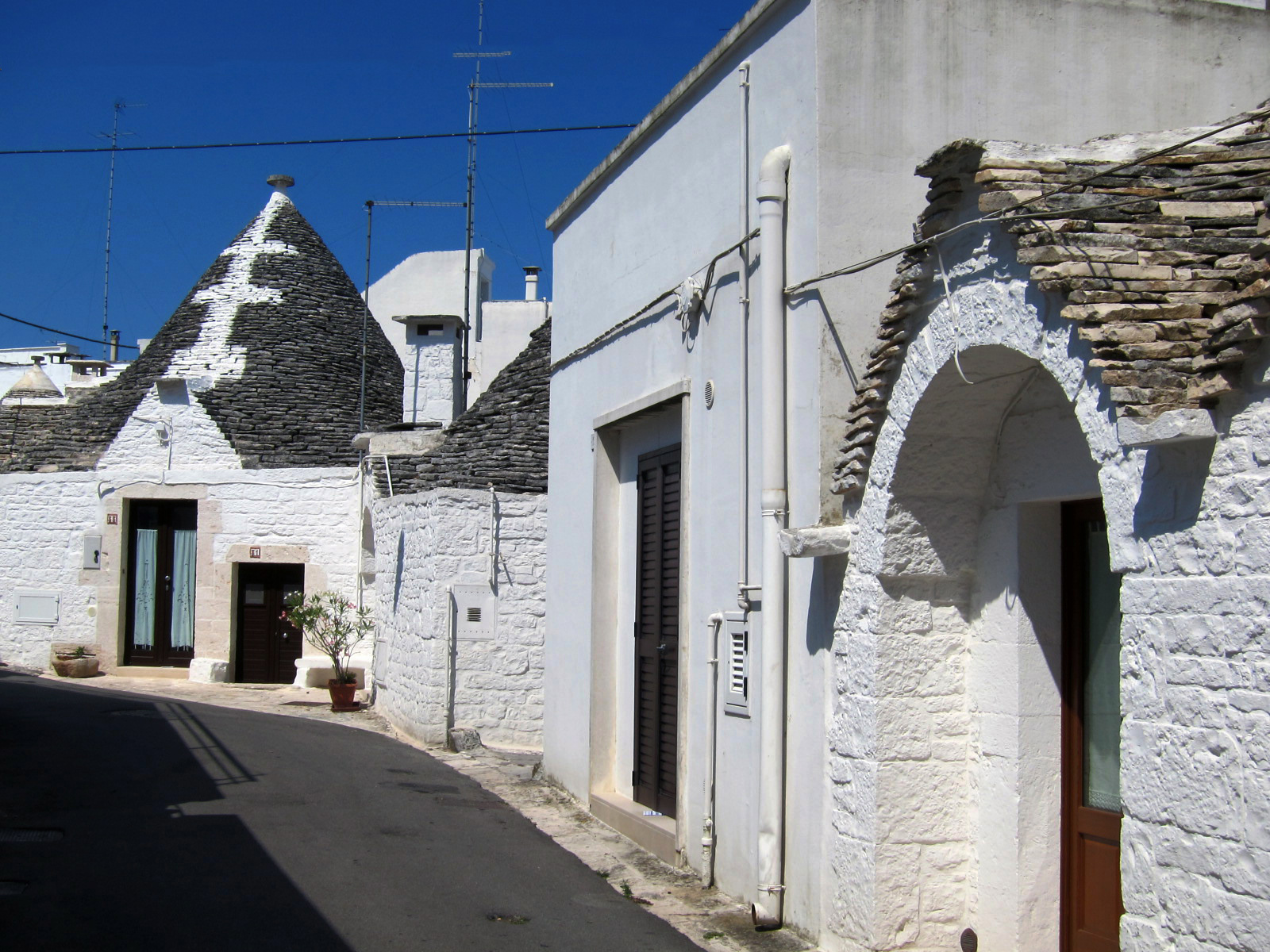 Some of the cones are painted with limestone symbols ranging from mystical pagan symbols, to a heart and arrow, to sun rays to Christian symbols, usually referring to Saints Cosma and Damiano, the patron Saints of Alberobello. The Basilica of Alberobello is the Chiesa dei Santi Medici Cosma e Damiano.
Some of the cones are painted with limestone symbols ranging from mystical pagan symbols, to a heart and arrow, to sun rays to Christian symbols, usually referring to Saints Cosma and Damiano, the patron Saints of Alberobello. The Basilica of Alberobello is the Chiesa dei Santi Medici Cosma e Damiano.
The historic (UNESCO) center is neatly carved into three areas. The Rione Monti is a series of small winding roads up the hillside. Its the most touristy part of the town filled with souvenir shops and restaurants.
The Aia Piccola, on the other side of the hill facing the Rione Monti is more residential.
 The third area is Piazza Sacramento, the location of the baroque Chiesa dei Santi Medici Cosma e Damiano and the Trullo Sovrano, the only two story trullo in existence. It’s now a museum (1.50€ each) and it’s still furnished with the original furnishings from the Sovrano family.
The third area is Piazza Sacramento, the location of the baroque Chiesa dei Santi Medici Cosma e Damiano and the Trullo Sovrano, the only two story trullo in existence. It’s now a museum (1.50€ each) and it’s still furnished with the original furnishings from the Sovrano family.
Older trulli are getting renovated and they’re turning into shops, vacation rentals and second homes. Because this is a UNESCO location (since 1996), the Trulli renovations have to adhere to the “Trulli Building Codes”. I read that is cost about 15,000€ to renovate a small trullo. Not too bad. There were many of them for sale.
For those who don’t want to renovate the older one, they are building newer versions as a cross between a contemporary house with trullo domes. The materials are all very available and they are pretty spectacular. We just saw the exteriors on the roads but the photos of the interiors are pretty spectacular.
We drove the main roads this time and getting up there was as easy as could be. We drove past Martina Franca, where they were hanging the decorations on the main street for the annual summer music festival. Onward north, we we passed the whitewashed, hillside city of Locorotondo, where the village was literally hanging off the cliff. From there, the road turned west and in 9km (10 minutes) we were in Alberobello. It was an easy drive.
We figured driving back would be just as easy. We were wrong. I think we were about 20 km from Taranto when I said, “I can’t believe we haven’t gotten lost once.” An hour later we were still trying to find our way out of the guts of Taranto, which looked like Naples on a bad day. During the glory days of 4th century BC Magna Grecia, this was a city of 300,000. During the time of the Romans it provided the empire with prized oysters and muscles and wool from its sheep. In 2006 it declared bankruptcy.
We passed the Duomo. We passed the Angevin Castle. We probably passed the ancient Greek and Roman ruins. We definitely passed through the 20th century ruins. And then, somehow, we were out of it and approaching the town of San Giorgio Ionico, 30 minutes from our villa. Saints be praised.
Even though Taranto is a pretty brutal city, it has one of the most famous dance stories in all history. In 17th century, the city was having problems with large wolf spiders (lycosa tarantula). If any of the town’s folk were bitten they would go into a fit of extreme agitation and die. In order to keep them alive, the locals decided they needed to keep moving in order to sweat out the poison, and so they created a dance, the Tarantella. As the dance got faster and faster the inflicted were spun around until they either survived the tarantula bite or died from exhaustion. “What tempo Captain?” “A Tarantella”, Captain Hook replied.
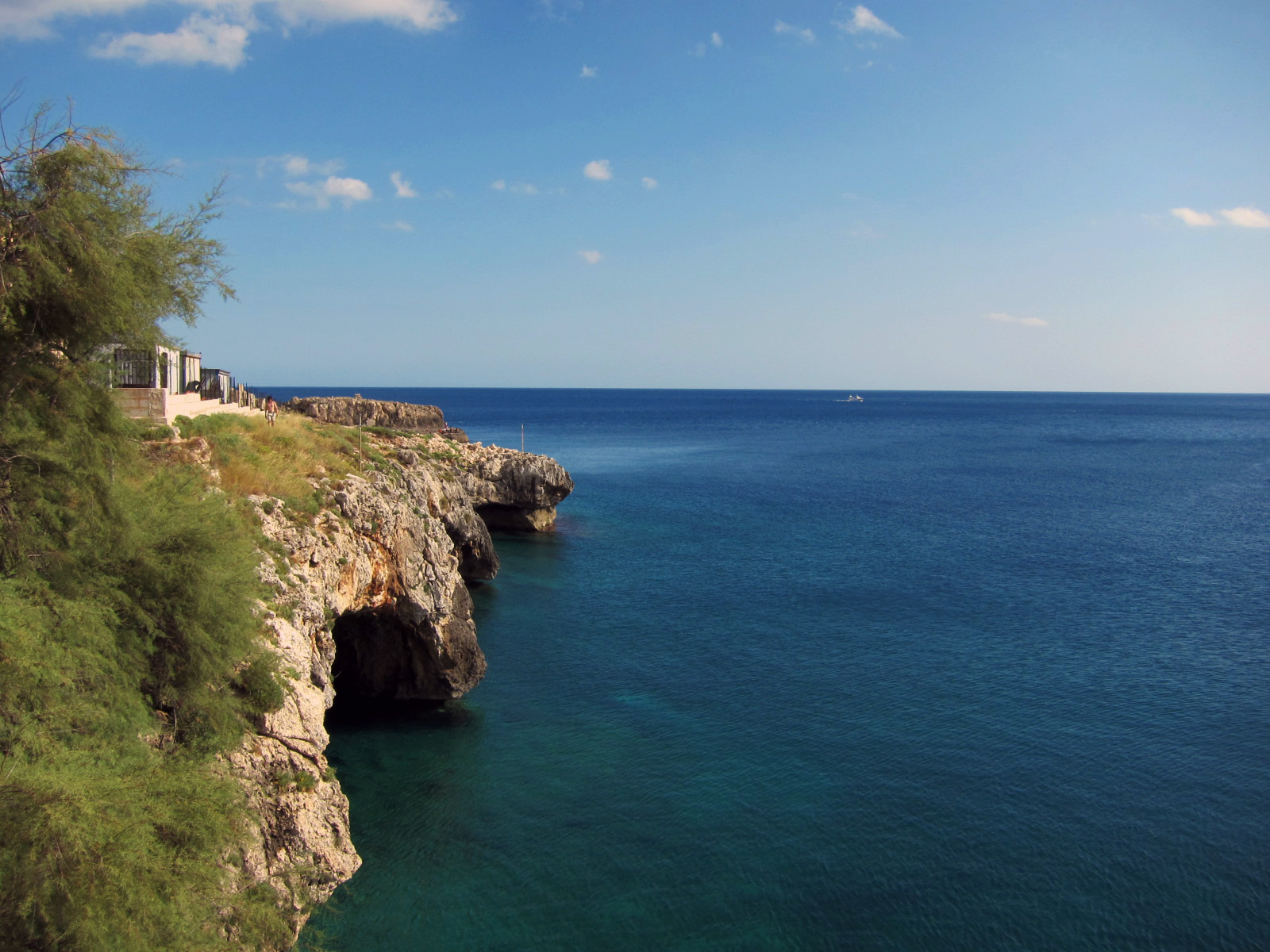 The Salento Peninsula – The Heel of Italy
The Salento Peninsula – The Heel of Italy
We took the beach road in front of our Villa and headed east past seaside resorts towards the beach town of Porto Cesareo, dodging families laden with umbrellas, beach chairs, cooler chests, children and dogs, crossing the road to get to their coveted positions by the sea.
From Porto Cesareo, we moved inland, levitating through Copertino till we got onto Highway 101 going south (that is indeed the name of the road) and 40 minutes later we were in Otranto, a really beautiful seaside town on the Adriatic Sea.
 The historical center is still protected by the old Castle fortress walls built in the 11th century. The Normans used Otranto as a port of embarkation to the Holy Lands in the 11th and 12th centuries. It was improved and fortified in the 13th century by the Swabian Hohenstaufen “Stupor Mundi” Frederick II who built two large cylindrical towers on the sea. The Castle was fortified again in 1490 by the Argonese after the city was sacked by the Ottoman Turks in 1480, but the new bulking up didn’t help much.The walls were breached again in 1537 by the Ottoman Corsair Barbarossa.
The historical center is still protected by the old Castle fortress walls built in the 11th century. The Normans used Otranto as a port of embarkation to the Holy Lands in the 11th and 12th centuries. It was improved and fortified in the 13th century by the Swabian Hohenstaufen “Stupor Mundi” Frederick II who built two large cylindrical towers on the sea. The Castle was fortified again in 1490 by the Argonese after the city was sacked by the Ottoman Turks in 1480, but the new bulking up didn’t help much.The walls were breached again in 1537 by the Ottoman Corsair Barbarossa.
The Castle saw its last military action in the 19th century as a Naval outpost of the French against the English. The last naval battle known here was in 1997 when the Italian navy sunk a boat filled with illegal Albanians trying to gain access to Italy.
In 1764, a English novelist named Horace Walpole wrote “The Castle of Otranto” which has the distinction of being the 1st gothic novel ever written. Walpole never came to Otranto. He just liked the sound of the name. Over the centuries, the Castle has gone through lots of renovations and now its used for small conferences, weddings and art installations.
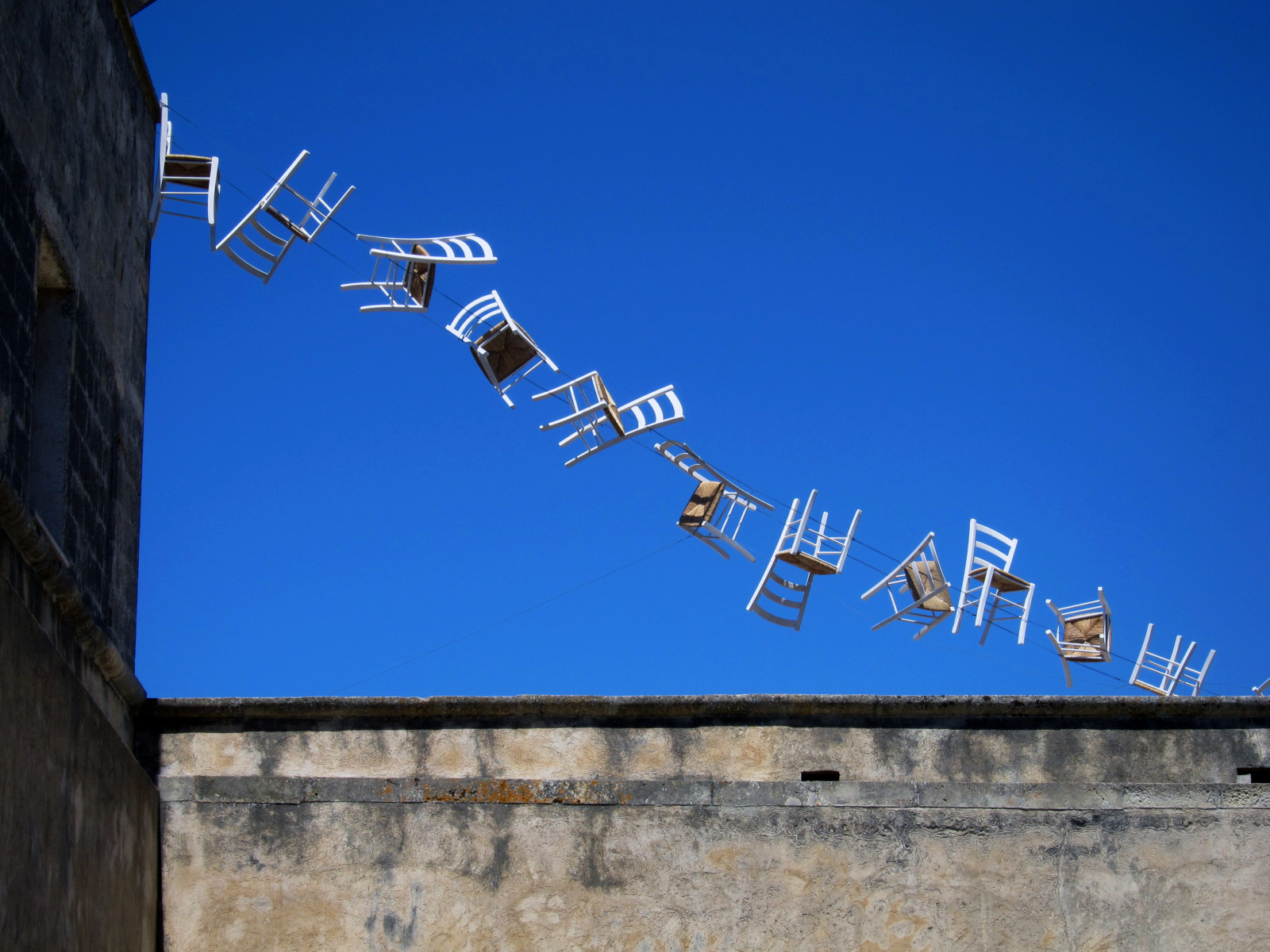 There was a Dali exhibit when we made our visit.
There was a Dali exhibit when we made our visit.
Apparently Salvador Dali was fascinated with Walpole’s book, especially the beginning of it when the son of the Lord of the Castle was killed by a large falling helmet. There was a room showing Dali’s sketches of the giant helmet crushing a man. There were also a lot of Daliesque tributes to Dali throughout the Castle, a lot of floating chairs.
The big attraction (for us) though was the Cathedral, which of course closed up its doors as soon as we arrived. This happens a lot to us.
No problem, it was easy for us to amuse ourselves for 3hrs in Otranto.
 The highlight of the Cathedral is an amazing mosaic floor from 1164, created by a Monk named Pantaleone. The Mosaic has a definite Norman influence and the artistic style is very reminiscent of the Bayeux Tapestry (the story of the William the Conqueror) in Bayeux France.
The highlight of the Cathedral is an amazing mosaic floor from 1164, created by a Monk named Pantaleone. The Mosaic has a definite Norman influence and the artistic style is very reminiscent of the Bayeux Tapestry (the story of the William the Conqueror) in Bayeux France.
The scenes of the floor are connected by the branches and roots of the tree of life. Under one of them Pantaleone signed his name but since the center of the floor was roped off and obscured by congregational benches we could only get an overview instead of an in depth study. Still there was enough to make the trip (and the wait) worth while. We could see Alexander the Great positioned below Noah’s ark. We walked around the Garden of Eden and the firey depths of hell. We could make out the 12 circles of the zodiac depicting what life was like during each of the 12 months of the year. In January, a man warms himself by the fire. In February, he pours water into a pot for a woman to roast a pig. In March there apparently isn’t much to do so the man just cleans his feet. By April, things start getting active and the man takes the flocks of sheep out for a walk. There is a summer festival in June and then the grain harvest in July. By August we have the grape harvest and in September the stomping of the grapes for wine. In the Fall the fields get ploughed, then comes the woodcutting for the winter and the year ends in December with a wild boar hunt. Not a bad year.
The lower section of the church, now called the Crypt looks as if it was in fact the original 11th century Cathedral. The columns and capitals are in perfect 11th century condition.
There is also a shrine in the church to the 800 innocents killed in the 15th century by the Turks. During the siege of 1480, the Turks killed 12,000 people. Afterwards they killed the 800 survivors when they wouldn’t renounce Christianity. The bones of these martyrs are interred in the Chapel of the Martyrs, kind of like an enormous reliquary.
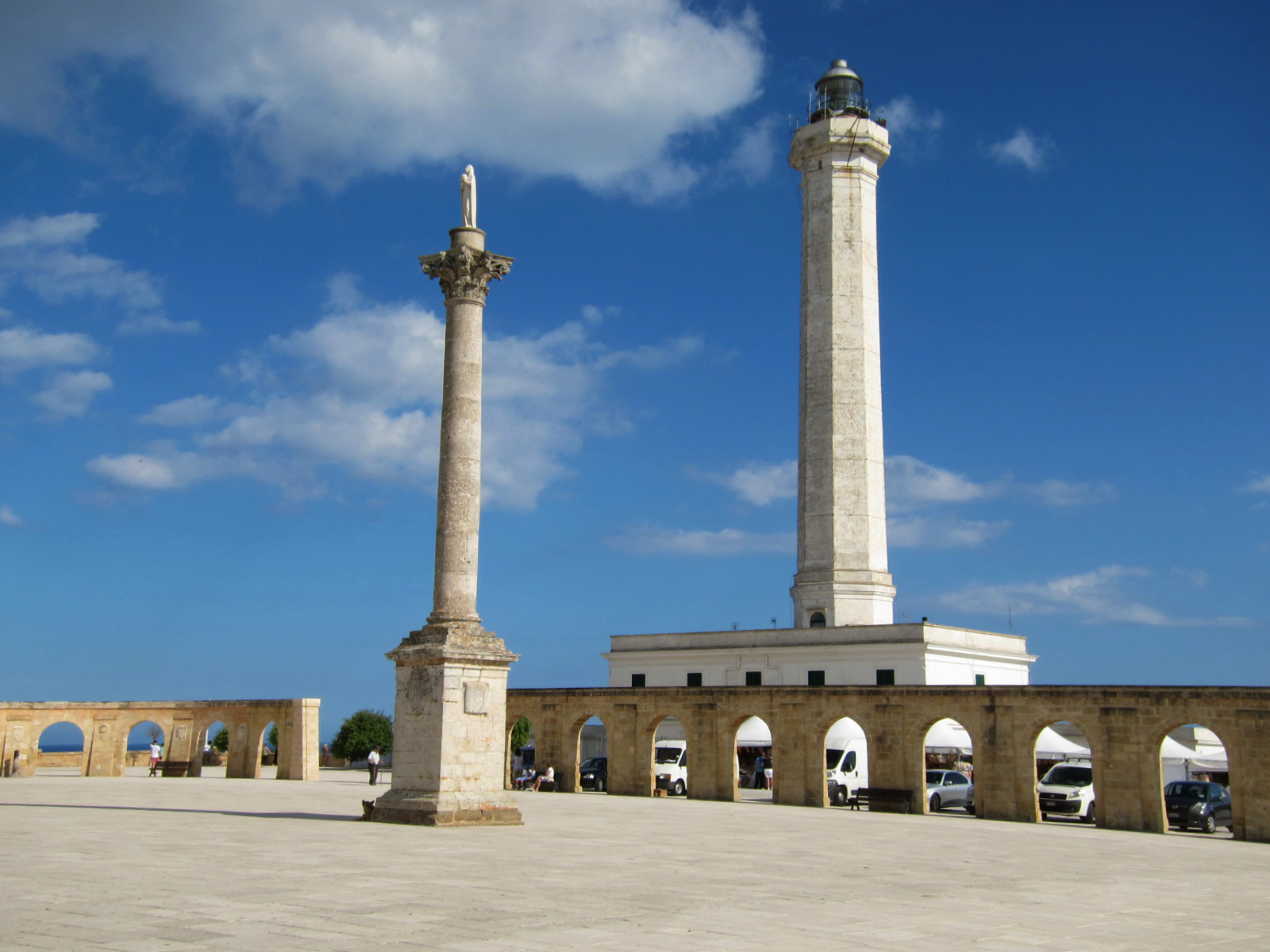 From Otranto we headed south to Santa Maria di Leuca, the tip of the Salento Peninsula and the end of Italy. You can see the tip of the heel of the boot of Italy here.
From Otranto we headed south to Santa Maria di Leuca, the tip of the Salento Peninsula and the end of Italy. You can see the tip of the heel of the boot of Italy here.
Gretchen read that the town was named after the white cliffs, Leuca in Greek. She’s probably right but there is another great story about the name. The town might be named after Leucasia, a beautiful white mermaid who charmed Greek sailors with her enchanting voice and saved them from crashing into the reefs. When the Christians took hold of the point, they claimed it was the Virgin Mary who saved sailors from the stormy seas, not the mermaid. Consequently, the name of the town was changed to Santa Maria di Leuca.
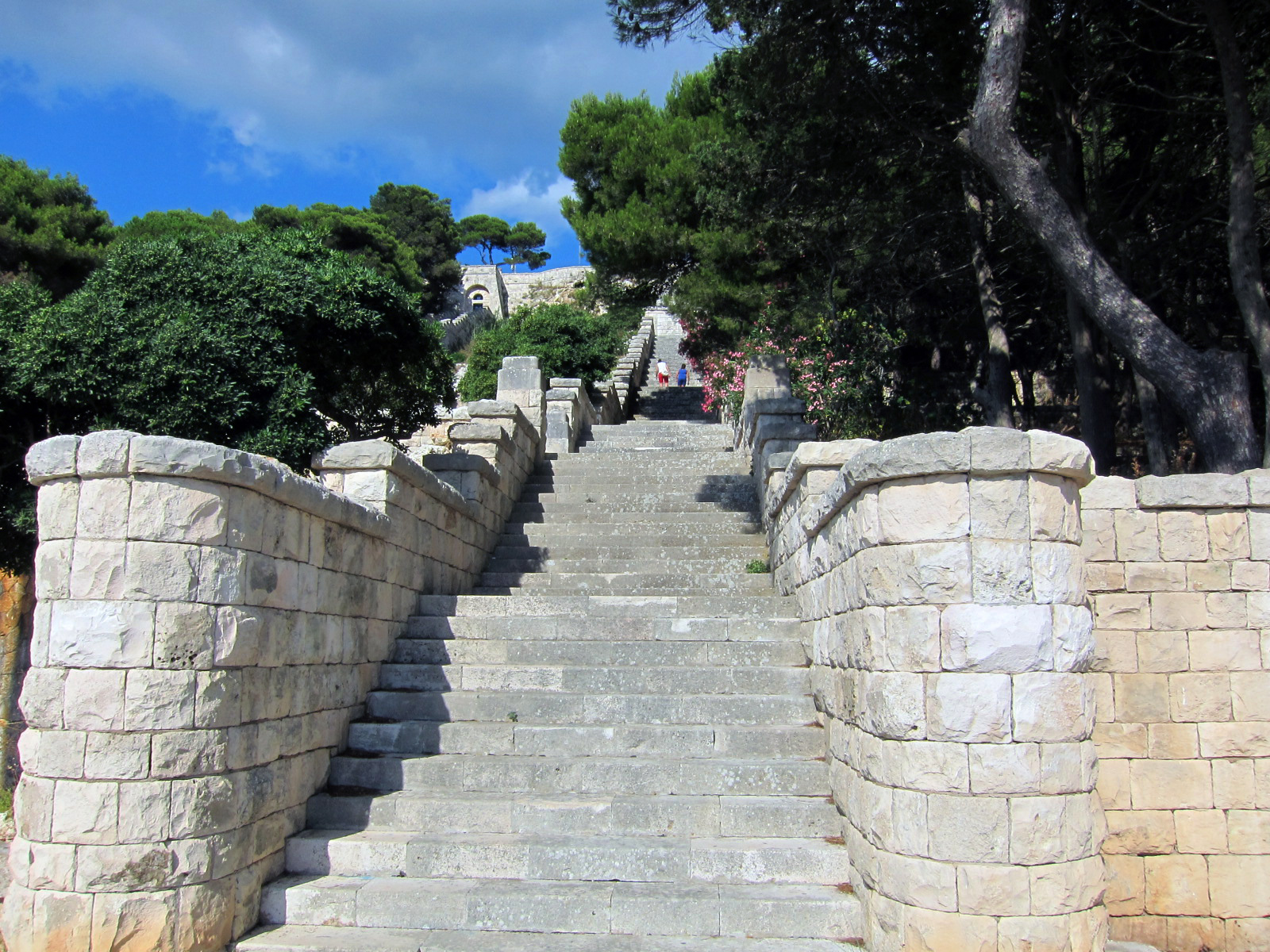 We drove down to the port filled with boat rentals and bars and walked up the 280 steps to the Piazza of the 155’ tall lighthouse, which sits next to the Basilica commemorating the spot where St Peter first arrived to Italy, and then we walk back down the 280 steps to the car.
We drove down to the port filled with boat rentals and bars and walked up the 280 steps to the Piazza of the 155’ tall lighthouse, which sits next to the Basilica commemorating the spot where St Peter first arrived to Italy, and then we walk back down the 280 steps to the car.
Off the coast at around 85 meter deep are the remains of the World War II Italian submarine Pietro Micca. All 58 on board perished. Neither the mermaid Leucasia or the Virgin Mary were able to help them.
From Leuca we got back on the super fast road and headed back north towards Gallipoli, a pretty seaside beach town on the west coast of the peninsula. Gallipoli means beautiful city in Greek, (kalli – beautiful ; polis-city). The old town is guarded by a 13th century Angevin/Argonese Castle fortress although most of the fortress wall has fallen. Still the old historical city is very pleasant and has that faded 18th century seaside feel to it.
We’re getting accustomed to the street signs and we didn’t get lost once getting back to the villa in Mirante. Yes, the blue directional signs were trying to lure us away from the coast road like some directional siren, but we learned to ignore them. We’ve learned that most of the directional signage in Puglia just wants to reroute you to the larger roads that can sometimes take you 20km out of your way. We hugged the coast.
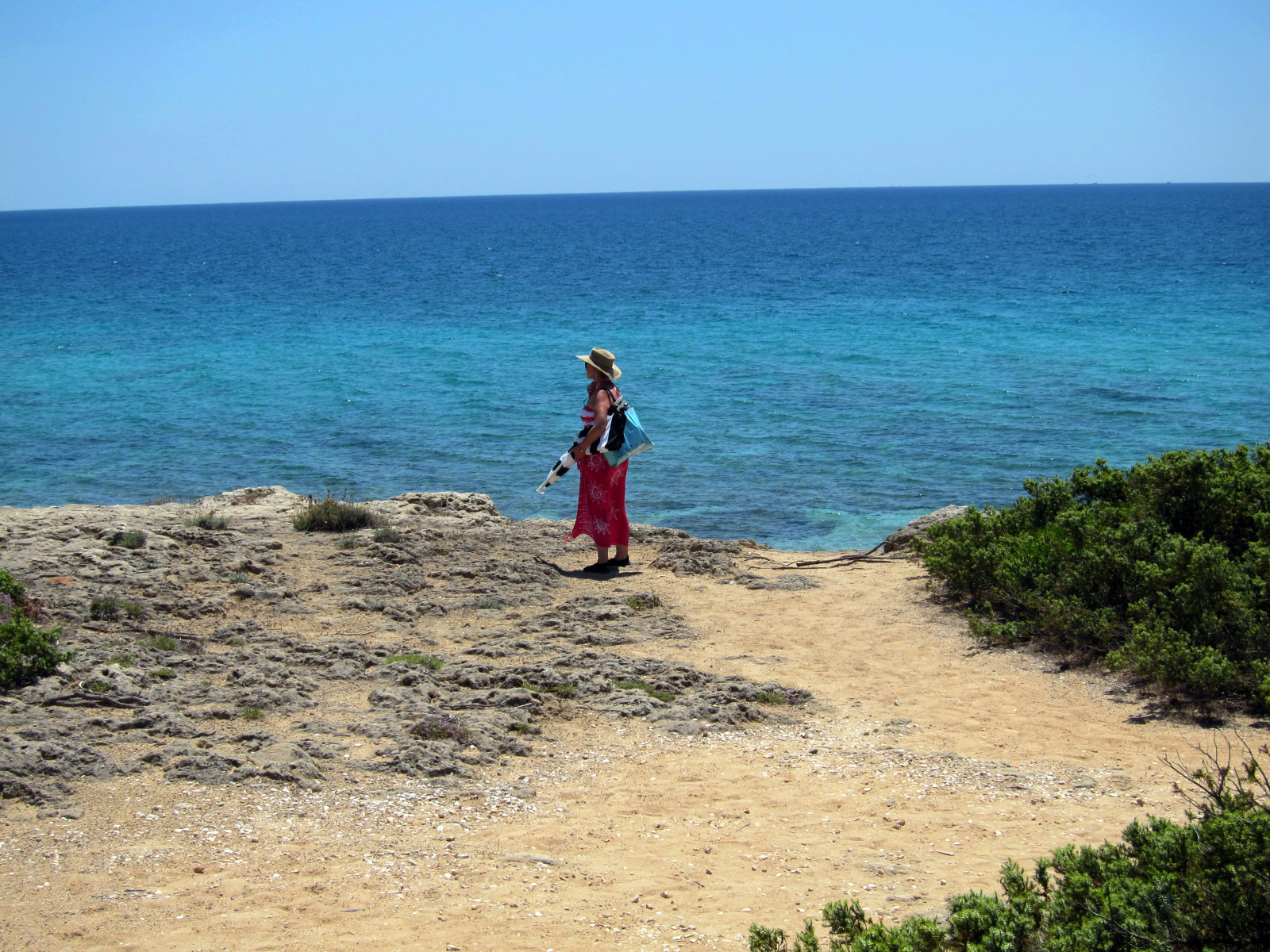 We spent our last day in Puglia at the villa and at the beach. It was a day to just sit and relax and we did an excellent job of it.
We spent our last day in Puglia at the villa and at the beach. It was a day to just sit and relax and we did an excellent job of it.
We never did make it back to Cannae. We didn’t get to Castel del Monte, the prize of the Stupor Mundi Castles. We never got to the 13th century frescoed cave churches of Mottola, north of Taranto. We never got to Bari or Brindisi. But we did a lot. And it’s always good to save some for the next visit.
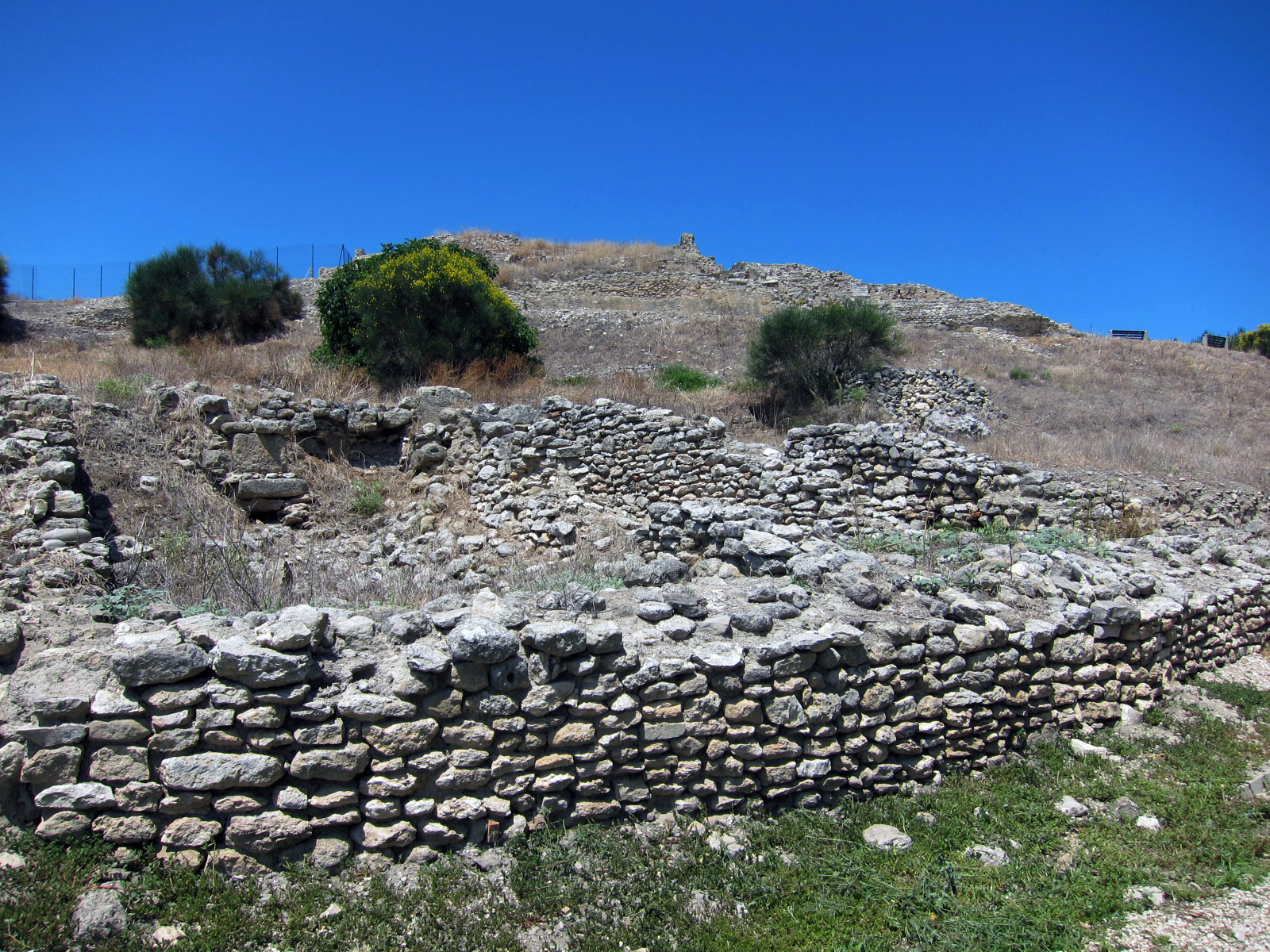
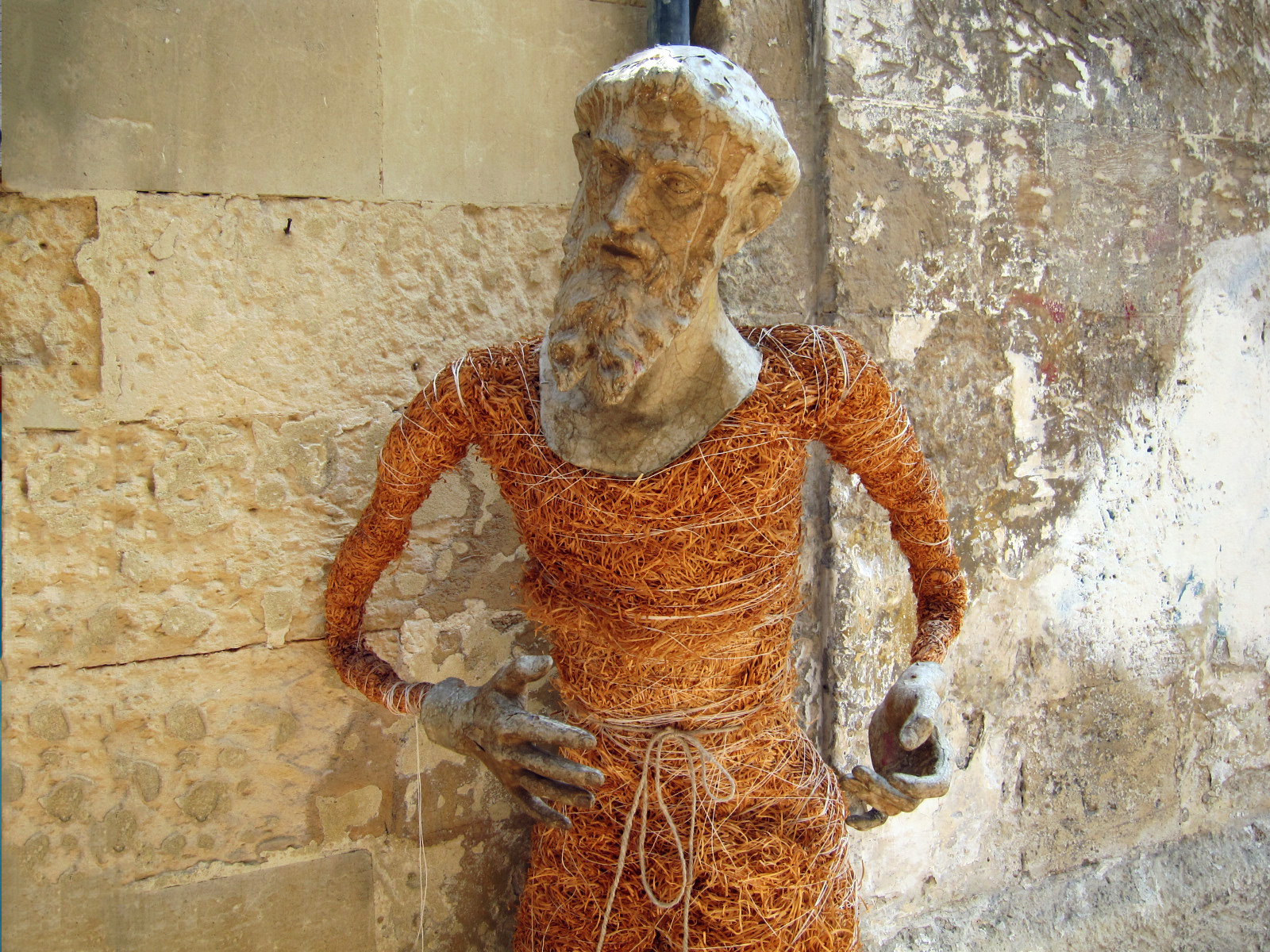
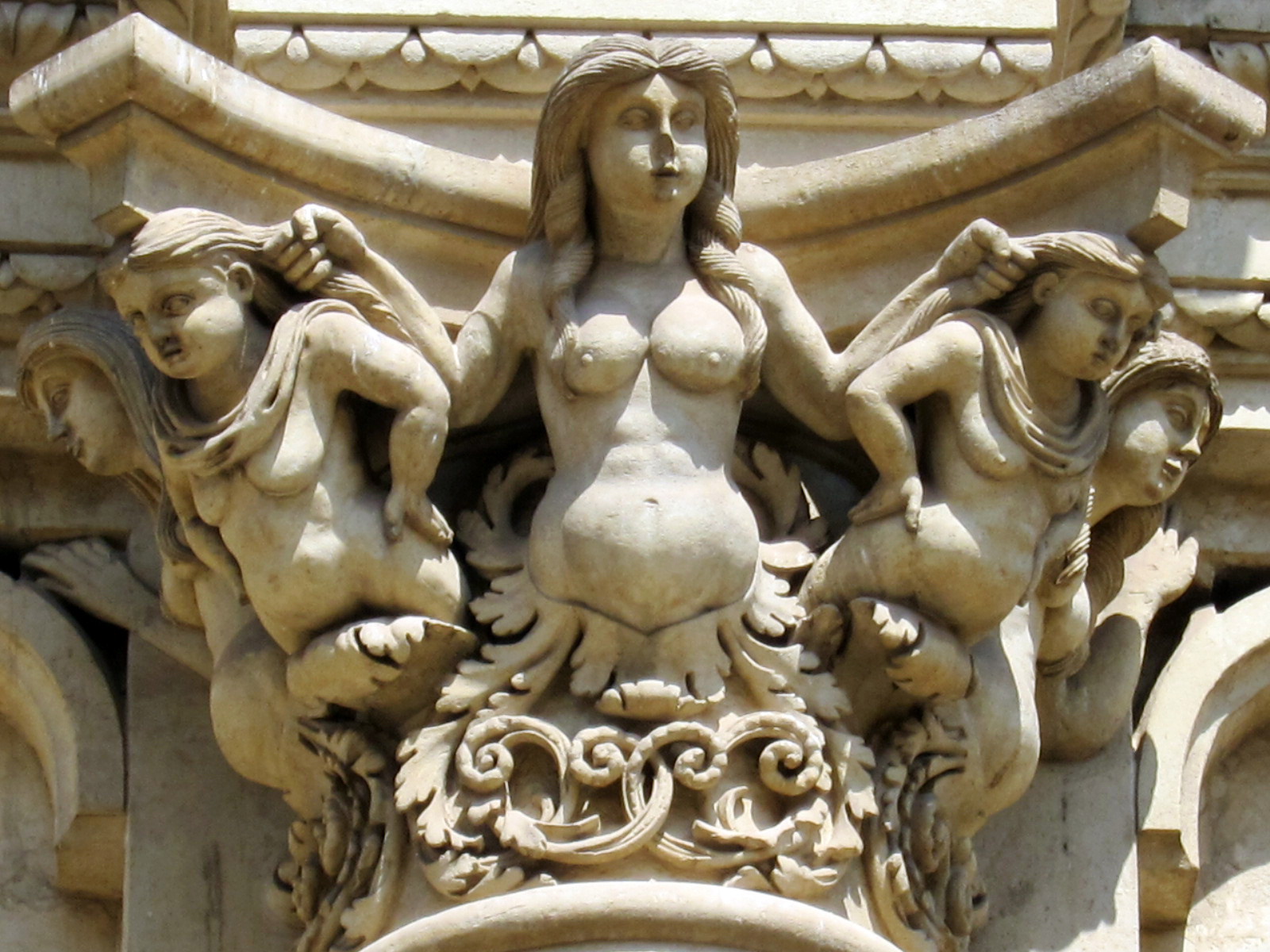
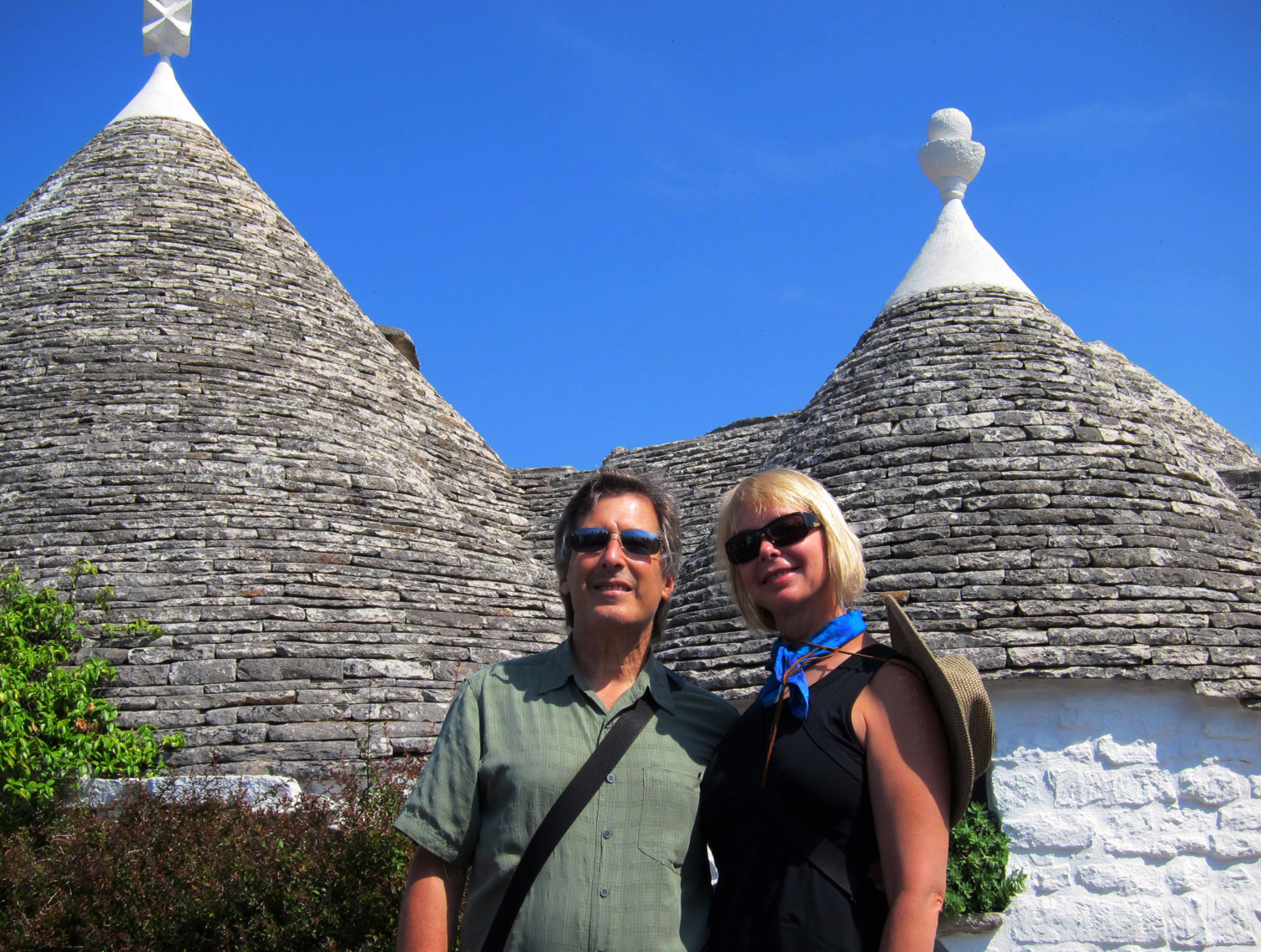
You must be logged in to post a comment.